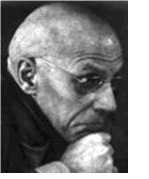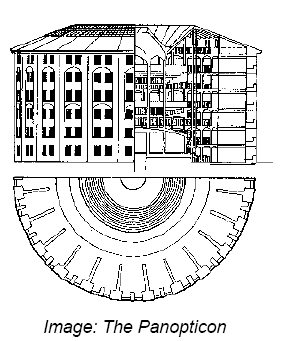Michel Foucault on the Power Dynamics in Modern Institutions
Michel Foucault (1926–84) was a French historian and philosopher who studied the modern institutions and the power relations within these institutions. Perhaps his most best known piece of historical analysis was of Jeremy Bentham’s ‘Panopticon’ prison design. Bentham (1748–1832) was a legal philosopher and advocate of prison reform. Foucault describes the ways in which power is exercised in modern institutions, such as prisons and schools.

We know the principle on which [Bentham's Panopticon] was based: at the periphery, an annular building; at the centre, a tower; this tower is pierced with wide windows that open onto the inner side of the ring; the peripheric building is divided into cells, each of which extends the whole width of the building; they have two windows, one on the inside, corresponding to the windows of the tower; the other, on the outside, allows the light to cross the cell from one end to the other. All that is needed, then, is to place a supervisor in a central tower and to shut up in each cell a madman, a patient, a condemned man, a worker or a schoolboy. By the effect of backlighting, one can observe from the tower, standing out precisely against the light, the small captive shadows in the cells of the periphery. They are like so many cages, so many small theatres, in which each actor is alone, perfectly individualized and constantly visible. The panoptic mechanism arranges spatial unities that make it possible to see constantly and to recognize immediately. In short, it reverses the principle of the dungeon; or rather of its three functions—to enclose, to deprive of light and to hide—it preserves only the first and eliminates the other two. Full lighting and the eye of a supervisor capture better than darkness, which ultimately protected. Visibility is a trap.

… Each individual, in his place, is securely confined to a cell from which he is seen from the front by the supervisor; but the side walls prevent him from coming into contact with his companions. He is seen, but he does not see; he is the object of information, never a subject in communication. The arrangement of his room, opposite the central tower, imposes on him an axial visibility; but the divisions of the ring, those separated cells, imply a lateral invisibility. And this invisibility is a guarantee of order. If the inmates are convicts, there is no danger of a plot, an attempt at collective escape, the planning of new crimes for the future, bad reciprocal influences; if they are patients, there is no danger of contagion; if they are madmen there is no risk of their committing violence upon one another; if they are schoolchildren, there is no copying, no noise, no chatter, no waste of time; if they are workers, there are no disorders, no theft, no coalitions, none of those distractions that slow down the rate of work, make it less perfect or cause accidents. The crowd, a compact mass, a locus of multiple exchanges, individualities merging together, a collective effect, is abolished and replaced by a collection of separated individualities. From the point of view of the guardian, it is replaced by a multiplicity that can be numbered and supervised; from the point of view of the inmates, by a sequestered and observed solitude.
Hence the major effect of the Panopticon: to induce in the inmate a state of conscious and permanent visibility that assures the automatic functioning of power. So to arrange things that the surveillance is permanent in its effects, even if it is discontinuous in its action; that the perfection of power should tend to render its actual exercise unnecessary; that this architectural apparatus should be a machine for creating and sustaining a power relation independent of the person who exercises it; in short, that the inmates should be caught up in a power situation of which they are themselves the bearers …
As opposed to the ruined prisons, littered with mechanisms of torture, to be seen in Piranese’s engravings, the Panopticon presents a cruel, ingenious cage. The fact that it should have given rise, even in our own time, to so many variations, projected or realized, is evidence of the imaginary intensity that it has possessed for almost two hundred years. But the Panopticon must not be understood as a dream building: it is the diagram of a mechanism of power reduced to its ideal form; its functioning, abstracted from any obstacle, resistance or friction, must be represented as a pure architectural and optical system: it is in fact a figure of political technology that may and must be detached from any specific use.
… [A]ny panoptic institution, even if it is as rigorously closed as a penitentiary, may without difficulty be subjected to such irregular and constant inspections: and not only by the appointed inspectors, but also by the public; any member of society will have the right to come and see with his own eyes how the schools, hospitals, factories, prisons function. There is no risk, therefore, that the increase of power created by the panoptic machine may degenerate into tyranny; the disciplinary mechanism will be democratically controlled, since it will be constantly accessible ‘to the great tribunal committee of the world’. This Panopticon, subtly arranged so that an observer may observe, at a glance, so many different individuals, also enables everyone to come and observe any of the observers. The seeing machine was once a sort of dark room into which individuals spied; it has become a transparent building in which the exercise of power may be supervised by society as a whole …
‘Discipline’ may be identified neither with an institution nor with an apparatus; it is a type of power, a modality for its exercise, comprising a whole set of instruments, techniques, procedures, levels of application, targets; it is a ‘physics’ or an ‘anatomy’ of power, a technology. And it may be taken over either by ‘specialized’ institutions (the penitentiaries or ‘houses of correction’ of the nineteenth century), or by institutions that use it as an essential instrument for a particular end (schools, hospitals), or by pre-existing authorities that find in it a means of reinforcing or reorganizing their internal mechanisms of power (one day we should show how intra-familial relations, essentially in the parents-children cell, have become ‘disciplined’, absorbing since the classical age external schemata, first educational and military, then medical, psychiatric, psychological, which have made the family the privileged locus of emergence for the disciplinary question of the normal and the abnormal); or by apparatuses that have made discipline their principle of internal functioning (the disciplinarization of the administrative apparatus from the Napoleonic period), or finally by state apparatuses whose major, if not exclusive, function is to assure that discipline reigns over society as a whole (the police).
… But the peculiarity of the disciplines is that they try to define in relation to the multiplicities a tactics of power that fulfils three criteria: firstly, to obtain the exercise of power at the lowest possible cost (economically, by the low expenditure it involves; politically, by its discretion, its low exteriorization, its relative invisibility, the little resistance it arouses); secondly, to bring the effects of this social power to their maximum intensity and to extend them as far as possible, without either failure or interval; thirdly, to link this ‘economic’ growth of power with the output of the apparatuses (educational, military, industrial or medical) within which it is exercised; in short, to increase both the docility and the utility of all the elements of the system.
The disciplines function increasingly as techniques for making useful individuals. Hence their emergence from a marginal position on the confines of society, and detachment from the forms of exclusion or expiation, confinement or retreat … Hence also their rooting in the most important, most central and most productive sectors of society. They become attached to some of the great essential functions: factory production, the transmission of knowledge, the diffusion of aptitudes and skills, the war-machine.
Foucault, Michel. 1979. Discipline and Punish: The Birth of the Prison. NY: Vintage Books. Image pp. 200–201, 205, 207, 215–216, 218, 211) || Amazon || WorldCat
